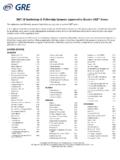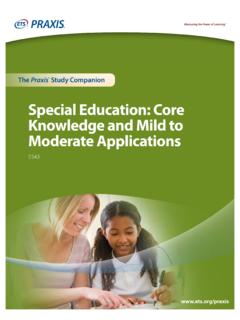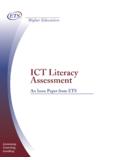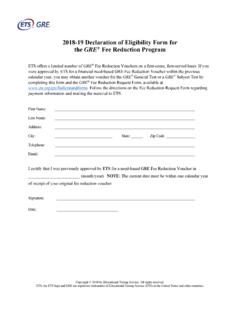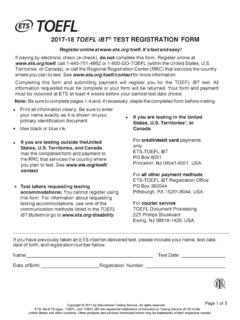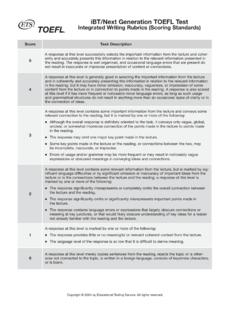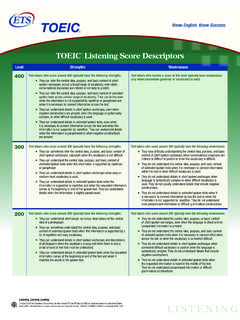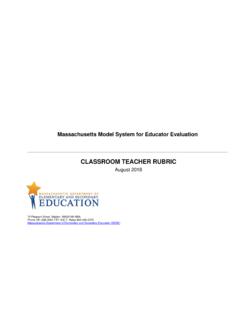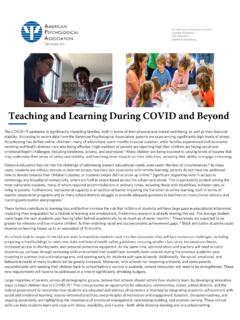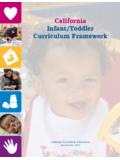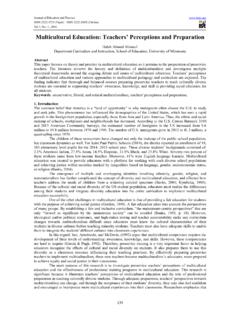Transcription of English to Speakers of Other Languages
1 English to Speakers of Other Languages Praxis Study CompanionThe Praxis Study Companion2 Welcome to the Praxis Study CompanionWelcome to The Praxis Study Companion Prepare to Show What You KnowYou have been working to acquire the knowledge and skills you need for your teaching career. Now you are ready to demonstrate your abilities by taking a Praxis test. Using the Praxis Study Companion is a smart way to prepare for the test so you can do your best on test day. This guide can help keep you on track and make the most efficient use of your study Study Companion contains practical information and helpful tools, including: An overview of the Praxis tests Specific information on the Praxis test you are taking A template study plan Study topics Practice questions and explanations of correct answers Test-taking tips and strategies Frequently asked questions Links to more detailed informationSo where should you start?
2 Begin by reviewing this guide in its entirety and note those sections that you need to revisit. Then you can create your own personalized study plan and schedule based on your individual needs and how much time you have before test in mind that study habits are individual. There are many different ways to successfully prepare for your test. Some people study better on their own, while others prefer a group dynamic. You may have more energy early in the day, but another test taker may concentrate better in the evening. So use this guide to develop the approach that works best for teaching career begins with preparation. Good luck!Know What to ExpectWhich tests should I take? Each state or agency that uses the Praxis tests sets its own requirements for which test or tests you must take for the teaching area you wish to you register for a test, confirm your state or agency s testing requirements at are the Praxis tests given?Praxis tests are given on computer.
3 Other formats are available for test takers approved for accommodations (see page 42).The Praxis Study Companion3 Welcome to the Praxis Study CompanionWhat should I expect when taking the test on computer?When taking the test on computer, you can expect to be asked to provide proper identification at the test center. Once admitted, you will be given the opportunity to learn how the computer interface works (how to answer questions, how to skip questions, how to go back to questions you skipped, etc.) before the testing time begins. Watch the What to Expect on Test Day video to see what the experience is and when are the Praxis tests offered?You can select the test center that is most convenient for you. The Praxis tests are administered through an international network of test centers, which includes Prometric Testing Centers, some universities, and Other locations throughout the schedules may differ, so see the Praxis web site for more detailed test registration information at The Praxis Study Companion4 Table of ContentsTable of ContentsThe Praxis Study Companion guides you through the steps to success1.
4 Learn About Your Test ..5 Learn about the specific test you will be taking2. Familiarize Yourself with Test Questions ..9 Become comfortable with the types of questions you ll find on the Praxis tests3. Practice with Sample Test Questions ..13 Answer practice questions and find explanations for correct answers4. Determine Your Strategy for Success ..22 Set clear goals and deadlines so your test preparation is focused and efficient5. Develop Your Study Plan ..25 Develop a personalized study plan and schedule6. Review Study Topics ..29 Review study topics with questions for discussion7. Review Smart Tips for Success ..40 Follow test-taking tips developed by experts8. Check on Testing Accommodations ..42 See if you qualify for accommodations that may make it easier to take the Praxis test9. Do Your Best on Test Day ..43 Get ready for test day so you will be calm and confident10. Understand Your Scores ..45 Understand how tests are scored and how to interpret your test scoresAppendix: Other Questions You May Have.
5 47 The Praxis Study Companion5 Step 1: Learn About Your Test1. Learn About Your TestLearn about the specific test you will be takingEnglish to Speakers of Other Languages (5361)Test at a GlanceTest Name English to Speakers of Other LanguagesTest Code 5361 Time 2 hours, including a 30-minute listening sectionNumber of Questions Section 1: 20 selected-response questions (listening*) Section 2: 100 selected-response questionsFormat Selected-response questionsTest Delivery Computer delivered Approximate Approximate Content Categories Number of Percentage of Questions Examination I. Foundations of Linguistics and Language 48 40% Learning Section 1, Parts A and B (Listening*) 20 Section 2 28 II. Planning, Implementing, and Managing 36 30% Instruction III. Assessment 18 15% IV. Cultural and Professional Aspects of the Job 18 15%* The Listening section in Category I is composed of 20 questions and will be reported as a separate section on the score This TestThe English to Speakers of Other Languages (ESOL) test is designed to measure basic linguistic and pedagogical knowledge within the context of teaching ESOL in elementary or secondary test is 2 hours long, including two timed 15-minute listening sections, parts A and B.
6 This test may contain some questions that do not count toward your has aligned the questions on this test with the TESOL/NCATE Standards for the Recognition of Initial TESOL Programs in P-12 ESL Teacher Education as developed by Teachers of English to Speakers of Other Languages , Inc. (TESOL), in collaboration with the Council for the Accreditation of Educator Preparation, Inc. (CAEP). ETS works in collaboration with teacher educators, higher education content specialists, and accomplished practicing teachers to keep the test updated and representative of current Praxis Study Companion6 Step 1: Learn About Your TestListening Portion: Section I, Parts A and B The 20 questions in Section I, Parts A (Oral Grammar and Vocabulary) and B (Pronunciation), are based on an audio recording. For Section I, you are asked to wear headphones to hear the audio recordings. You are able to adjust the volume. The recorded questions in Section I are based on speech samples recorded by students who are not native Speakers of English ; you will be asked to identify errors in the students speech.
7 Therefore, before taking the test, you should be familiar with the speech of nonnative Speakers who are learning English . A transcript of each of the recorded speech samples appears on screen. As you listen to the recordings, note the students errors using scratch paper. The speech samples in Part A are played one time only. The speech samples in Part B are played twice. After each speech sample, a clock at the top of the screen shows you how much time is remaining to answer each question. When the response time has ended you automatically advance to the next question. You are not able to return to previous questions. Ten questions cover oral grammar and vocabulary via recorded excerpts of English spoken by a nonnative speaker . The excerpts, questions, and suggested answers are printed in the test book. The format for the next 10 questions is similar. The questions concern pronunciation, and each excerpt is played SpecificationsTest specifications in this chapter describe the knowledge and skills measured by the test.
8 Study topics to help you prepare to answer test questions can be found on page Foundations of Linguistics and Language LearningA. Linguistic Theory1. Phonetic transcription and terminology, stress and intonation patterns, and the effects of phonetic environment on pronunciation2. Types of morphemes ( , stem/root and affix, bound and free, derivational and inflectional) and how words are morphologically related to each other3. English syntax ( , how words are combined into phrases and sentences, and transformations such as question formation)4. The parts of speech and the tenses of English verbs5. Basic features of semantics and how combinations of words convey meaning ( , phrases, sentences, and idioms)6. Familiarity with differences among Languages in terms of their phonology, morphology, syntax, and semanticsB. Language and Culture1. Basic concepts of pragmatics and sociolinguistics ( , that language varies according to a speaker s identity, purpose, and context)2.
9 Understanding the nature and value of World Englishes and dialect variation3. The concept of communicative competence4. Range of social and academic language functions required for English -language proficiencyC. Second-Language Learning1. Familiarity with research-based models for second-language learning and acquisition ( , cognitive, behaviorist, constructivist)2. Second-language acquisition, first-language acquisition, and how learners first language can affect their second-language productions ( , L1 interference, accent, code switching)3. Stages of second-language acquisition ( , silent period, interlanguage, morpheme acquisition order)4. Types of student motivations (intrinsic and extrinsic) and their implications for the second-language learning process5. Language modeling, comprehensible input, and scaffolding in language learningD. Literacy1. Relationships between English phonemes and graphemes as well as the differences between English pronunciation and spelling2.
10 Conventions of standard written English and the range of genres and rhetorical patterns used in written English3. Familiarity with current approaches to literacy development4. Stages of English literacy development and the importance of oral language skills to literacy developmentThe Praxis Study Companion7 Step 1: Learn About Your Test5. First-language literacy influences on the development of English literacyII. Planning, Implementing, and Managing InstructionA. Instructional Theory1. Characteristics, theoretical foundations, and appropriate use of methods and approaches in second-language learning ( , the direct method, Total Physical Response, the Natural Approach)2. Various instructional delivery models ( , push in, pull out, sheltered instruction)B. teaching Techniques1. Organizing learning around content and language objectives and aligning learning with standards2. Age-appropriateness of language instruction3. Collaboration with general education and content area teachers when designing classroom activities appropriate to the language acquisition levels of English -language learners4.


